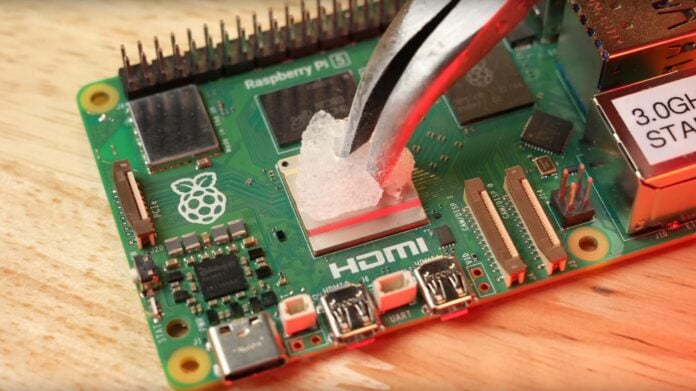A YouTuber has snagged the Geekbench 6 world record on Raspberry Pi 5. To do so, he needed custom firmware plus advanced active cooling, not to forget a lot of trial and error.
A tech enthusiast managed to claim Geekbench 6’s world record on a Raspberry Pi 5 by overclocking the CPU to 3.4GHz using 1.09V. This 1GHz extra frequency allowed him to hit 1,121 single-core points and 2,219 multi-core points. These are respectively 41% and 37% higher than the stock configuration, which netted 794 single-core points and 1,612 multi-core points.
As you can guess, higher voltages bring higher temperatures, as it pushed nearly 70°C while pulling around 20W from the wall. Though it seems within the usual for general PCs, it’s considerable for Raspberry Pis that tend to thermal throttle around 85°C. To keep temperatures under control, Jeff swapped for a Peltier thermoelectric cooler which uses electricity to transfer heat from one side touching the chip to the other contacting the heatsink.
This wasn’t Jeff’s first attempt at Pi 5 overclocking as his last attempt reached 3GHz. He couldn’t go further due to a firmware-locked voltage.
This record didn’t come cheap. The YouTuber got only a single chip out of ten capable of hitting speed due to silicon lottery. That’s why extreme overclockers always have sample trays filled with hundreds of CPUs to find the best one to put under LN2 (liquid nitrogen). As a reminder, a barebone 4GB Pi 5 retails for £48 or £64 for 8GB of RAM.
Now, is heavy overclocking worth considering for daily Raspberry use? The answer is, as you can expect, no. This former efficient machine became too hungry and hot, consuming double the power and requiring advanced cooling. Unfortunately going the other way around isn’t good either as underclocking reduces performance noticeably, unlike desktop CPUs which keep most of their performance.
According to Jeff, the sweet spot for the Pi 5 sits around the 2.4GHz frequency you get out of the box, where both efficiency and performance meet. The higher you go, the less performance you get per watt consumed. And the more watts the machine consumes greater the heat output becomes, requiring better cooling solutions.


